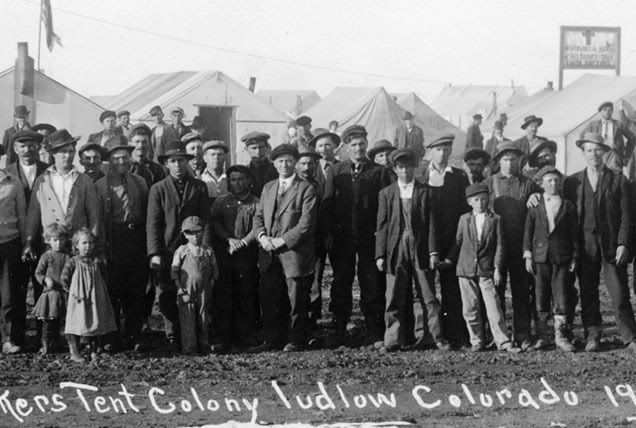
Ludlow Massacre Funeral
Sandra Dallas of The Denver Post writes "Killing for Coal" mines history of labor in West, on 15 February 2009 -- Pioneers may have been lured west by gold, but they stayed because of coal. Coal was a critical underpinning of the West's economy, posits Thomas G. Andrews in "Killing for Coal: America's Deadliest Labor War."

Ludlow funeral
William Jackson Palmer, founder of Colorado Springs, built his Rio Grande Railroad empire to take advantage of nearby coal fields. And many Eastern financial titans, such as John D. Rockefeller Jr., put their money into coal instead of precious metals.
It was coal, of course, that was the basis of the 1913-14 strike in southern Colorado, the deadliest uprising in labor history up to that time. Nearly 100 deaths are attributed to the strike, among them the "massacre" on April 20, 1914, of two women and 11 children in a cellar in the strikers' tent colony of Ludlow.
As the women and children huddled together to escape militia bullets, their tent caught fire. It was a "slaughter of the innocents," one journalist wrote. "Little children were roasted alive," famed labor leader Mother Jones cried, although the 13 actually died of asphyxiation.
Never mind. "Remember Ludlow" became a rallying cry, not just in Colorado but also by union members all over the country. Labor relations changed as a result of the Colorado coal strike. (And for better or worse, the public- relations industry got its start in the coal fields, when Rockefeller hired publicist Ivy Lee to clean up the financial baron's image. Among other things, Lee suggested that Rockefeller hand out dimes to poor kids on the streets.)
Andrews, an assistant history professor at the University of Colorado Denver's campus, goes well beyond the story of Ludlow in a groundbreaking work about coal and coal development, labor relations and class conflict.
He begins with men like Palmer discovering the black riches under the earth and ends with a tragedy pitting greed against human rights. It is a complex story that from the beginning set owners against workers.
Many of those employees were immigrants, lured to the coal fields with promises of decent wages. Some loved the work. "Once anybody start working at the mine, they won't do anything else. They just fall in love with it somehow," a collier said. Another remarked, "Boy, I'm telling ya, that . . . mine, it put something in you, see, that's what it does."
Ludlow Ruins
More colliers, however, found the work dangerous and inhumane. When "everything go wrong in the mine, (the workers) would come out and they take it out on the woman, you know, or the kids," a miner's daughter said. The men drank, sometimes on the job, and their anger often erupted into violence. Between 1880 and 1920, the homicide rate in coal-rich Las Animas County was eight times that of New York.
Conditions underground were atrocious. The Colorado coal mines were fetid, vermin-ridden and gassy. Because their pay was based on production, the miners spent as little time as possible on anything but digging out the coal, which left the mines unstable and vulnerable to cave-ins.
Living conditions weren't much better. A Denver reporter, watching the procession of wagons on their exodus from the mine camps to the Ludlow colony, wrote about the sad-faced women and children, their faces twisted in misery:

"What a mockery of the state's boasted riches! Prosperity! Little piles of rickety chairs! Little piles of miserable looking straw bedding. . . . And all so worn and badly used they would have been the scorn of any second-hand dealer."
The workers did not win. Poverty and the relentless opposition of mine owners and politicians doomed the strike, and the demoralized miners went back to work. In fact, that first strike led to more strikes, so that Ludlow marked "not the endpoint of class conflict in the region, but rather the most dramatic movement in an ongoing history of struggle," Andrews writes.

Eventually, as coal deposits were depleted and the nation turned to other forms of energy, the miners moved on, and their descendents were scattered across the nation.
The landscape is scarred and deserted, and the tiny collier houses are vacation homes. Labor laws protect workers today. Still, we have not come all that far. The kind of class conflict that spawned Ludlow remains, Andrews claims. Just look at the world, he tells readers. Corporate decisions have a negative effect on workers in Third World countries and environments around the globe. It is not an encouraging outlook.
Writes Andrews: "The past has forged the road along which we are traveling."

[source: The Denver Post ; Sandra Dallas is a Denver novelist, Read more: "Killing for Coal" mines history of labor in West - The Denver Post; http://www.denverpost.com/search/ci_11694868#ixzz1tuQapbGD]


No comments:
Post a Comment